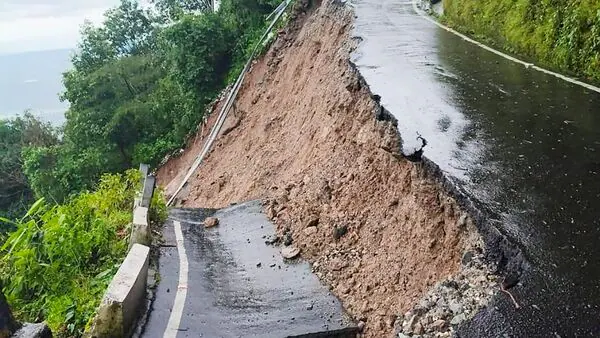
Govt Turns To Swiss Expertise To Make Mountain Roads Damage-Resistant
NEW DELHI: The government has decided to implement Swiss model to design road networks along mountainous terrain to make them strong and damage-resistant to extreme weather events seen in the country's hilly states.
According to two persons aware of the development, after evaluating the highway construction techniques in a mostly-mountainous Switzerland, the ministry of road transport and highways (MoRTH) has sought consultancy from the European nation to design physical mechanisms to prevent the occurrence of extensive damage to the road infrastructure along 50 black spots, or accident-prone zones, initially. More spots would be identified for the strengthening exercise later.
“In a first, MoRTH had identified close to 200 black spots along highways on the mountains that may be prone to landslides or are unstable. About 50 of these are being redesigned using Swiss model of construction. Efforts are on to identify more such black spots in these regions and prepare a plan to strengthen them," said the first of the two persons cited earlier, both of whom spoke on the condition of anonymity.
Also Read | India plans overseas roadshows in Japan, Korea to anchor shipping paThe ministry of road transport and highways defines a black spot as a stretch of national highway of about 500 meters, where either five or more accidents involving fatalities/grievous injuries, or ten or more fatalities, occurred in the past three calendar years.
States and Union territories with significant mountainous terrain, such as Himachal Pradesh, Uttarakhand, Jammu & Kashmir, Ladakh, Sikkim, and other North-Eastern states have a combined National Highway length of roughly 22,000 km. This represents about 15% of the total National Highway network, which currently stands at round 1,46,500 km.
“We have gone for Swiss technology and expertise in designing and strengthening mountain roads as the Himalayan landscape in india presents very similar features to mountains in Switzerland. The Swiss have managed to build strong road network and contained natural events from impacting their highways. We now want to see if the same designing and construction techniques make even Indian highways safer," said the second person.
Queries sent to the MoRTH remained unanswered till the press time.
Climate events increase urgencyThe recent rains and flooding in Himachal Pradesh, and Uttarakhand resulted in extensive damage to highway network, snapping off connectivity to affected portions of the states from the rest of the country. In various places, large stretches of highways just got washed away, while on several locations roads, caved in on frequent landslides. The frequency of such events has increased in recent years and climate change events have begun impacting highway network every year.
Also Read | Centre shifts focus from size of public capex to quality and impact of spend“While identifying black spots is a step in the right direction, India needs to treat highway safety as a national public health and infrastructure priority. Redesigning high-risk stretches in mountainous regions is particularly important as these areas are strategically significant, often face the brunt of extreme weather, and given the current geopolitical environment strengthening them should be a national priority. Doing so will not only enhance connectivity but also bolster national resilience," said Shailesh Agarwal, partner, risk consulting (infrastructure), EY India. "Leveraging proven global expertise, such as Swiss technology, known for its safety and durability, can help India accelerate progress and set new benchmarks for road safety and engineering excellence."
New road safety policyThe Swiss model of road construction on mountainous terrain uses a mix of innovative bio-technologies including geosynthetic fibres to strengthen soil surfaces that prevents landslides and keeps the slopes around roads stable. This technique is used along with integration of monitoring and early warning systems at road design stage itself. This real-time monitoring system detects rock mass movement and deformation to provide early warnings of potential stability issues.
The government is also working on a policy on road design required for areas that experience heavy rainfalls. The policy would also look at the need for creating physical barriers and breakwater walls - a protective structure meant to reduce the force of water such as tides and waves against road or other infrastructure - to arrest landslides that destroy infrastructure, the people cited above said. It is expected that the policy will draw a lot of inputs from the Switzerland-system in dealing with such situations.
Also Read | Centre launches third PLI round for speciality stAs part of its exercise to make Indian roads safer and less prone to damage from extreme climatic conditions, the MoRTH has also developed guidelines with technical assistance from Japan International Cooperation Agency. It has developed five guidelines aimed at enhancing mountainous road infrastructure in India. These guidelines, unveiled in 2023, are designed to ensure high-quality and sustainable road projects in hilly regions, which will improve road networks and promote economic growth.
The guidelines provide technical specifications and best practices for road construction in mountainous regions, covering planning of hilly roads, slope protection and embankment with advanced technology, tunnel on arterial roads in hilly area, mountain bridge with advance technology, operation and maintenance of mountainous highways.
Legal Disclaimer:
MENAFN provides the
information “as is” without warranty of any kind. We do not accept
any responsibility or liability for the accuracy, content, images,
videos, licenses, completeness, legality, or reliability of the information
contained in this article. If you have any complaints or copyright
issues related to this article, kindly contact the provider above.

















Comments
No comment